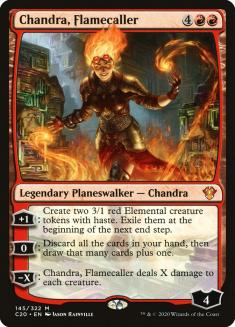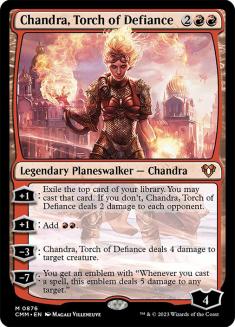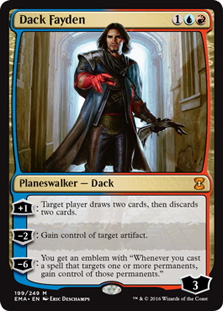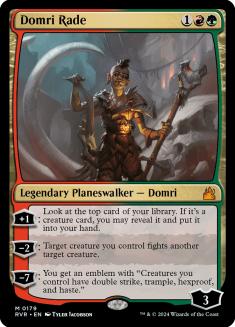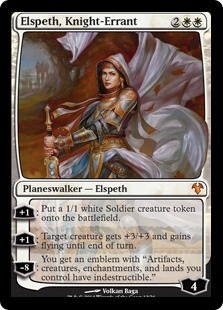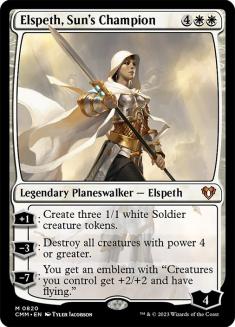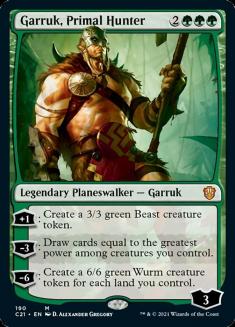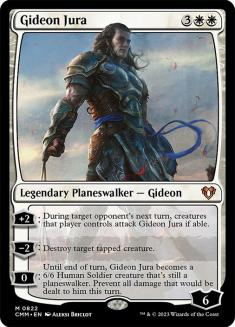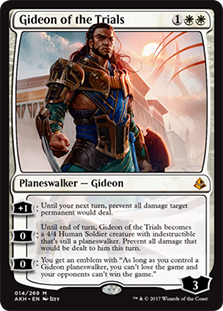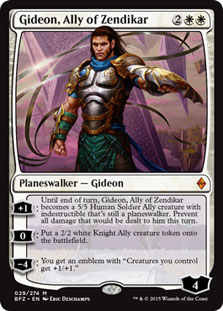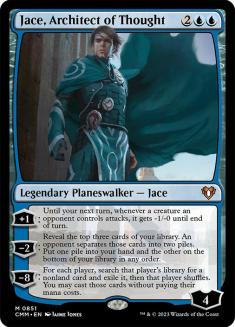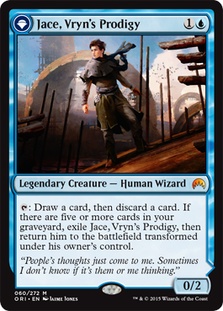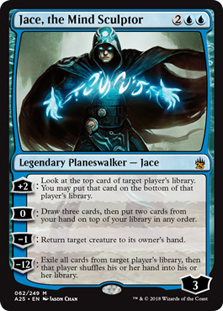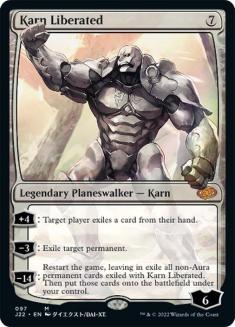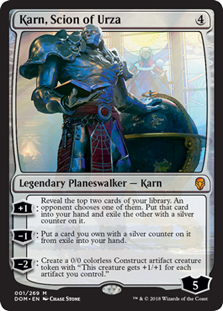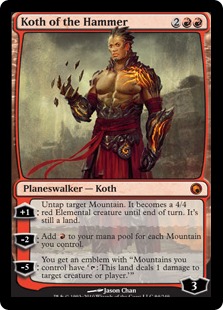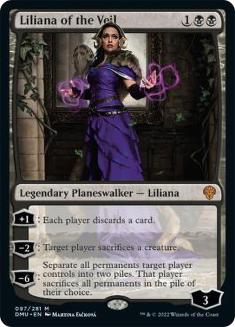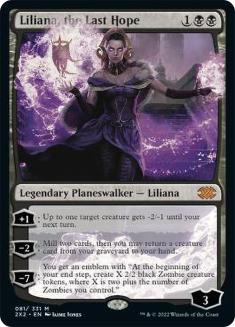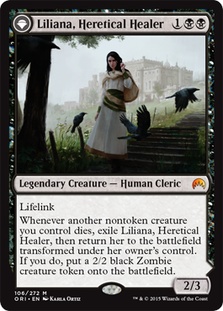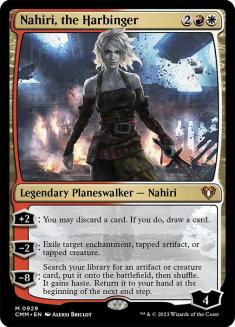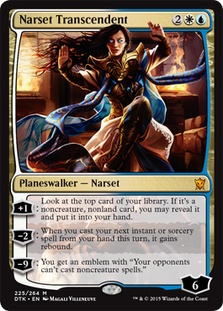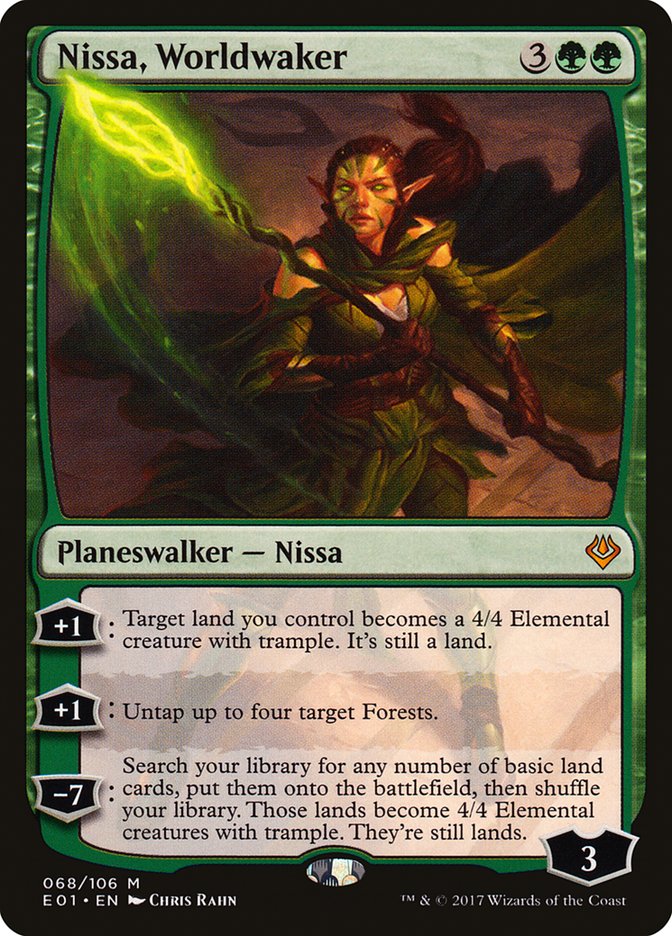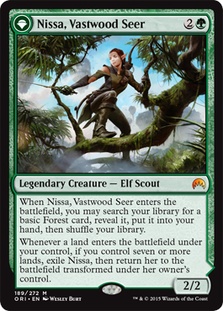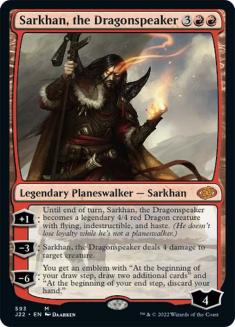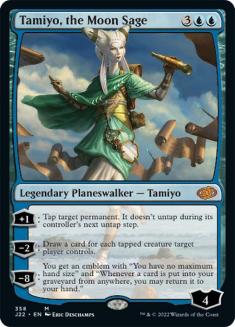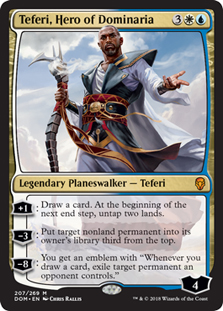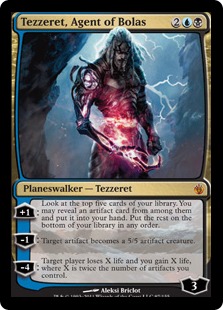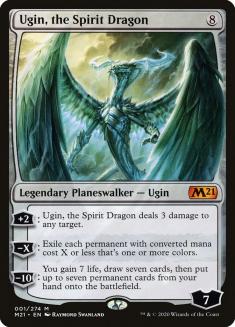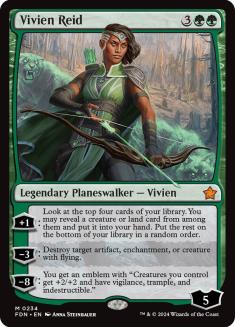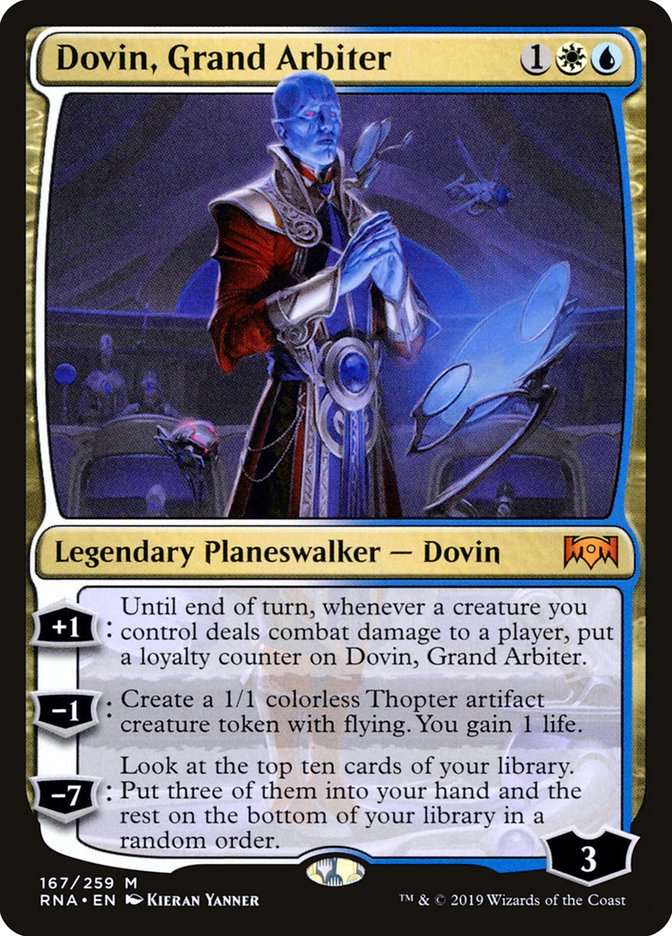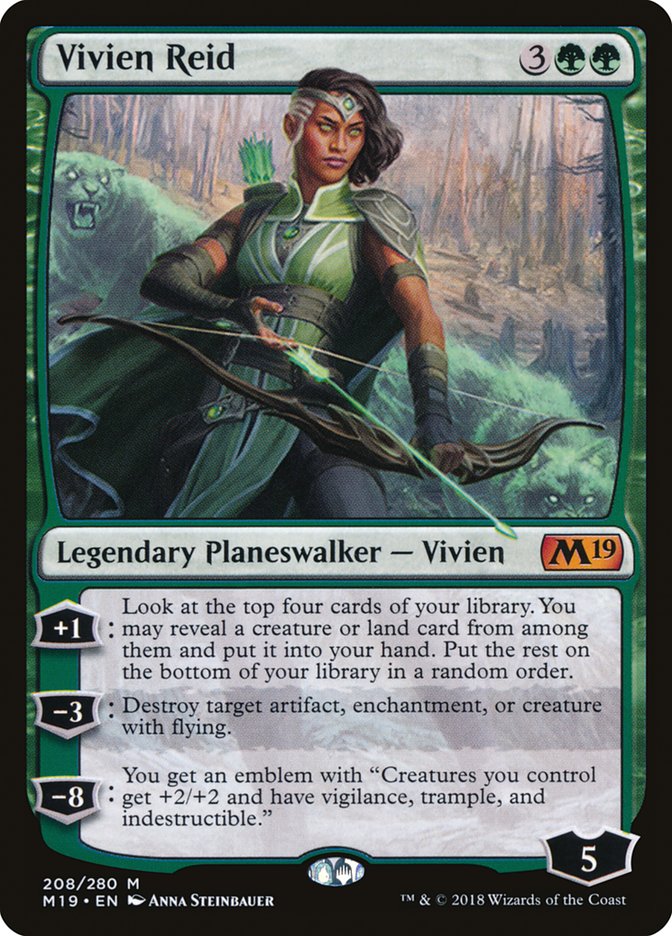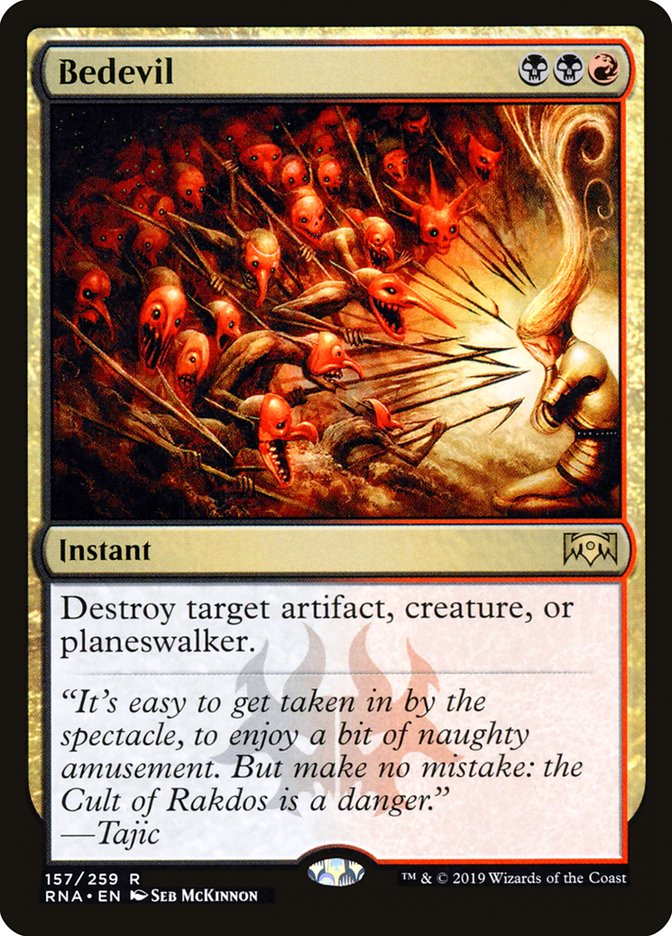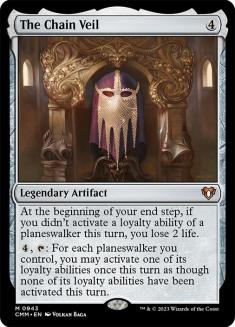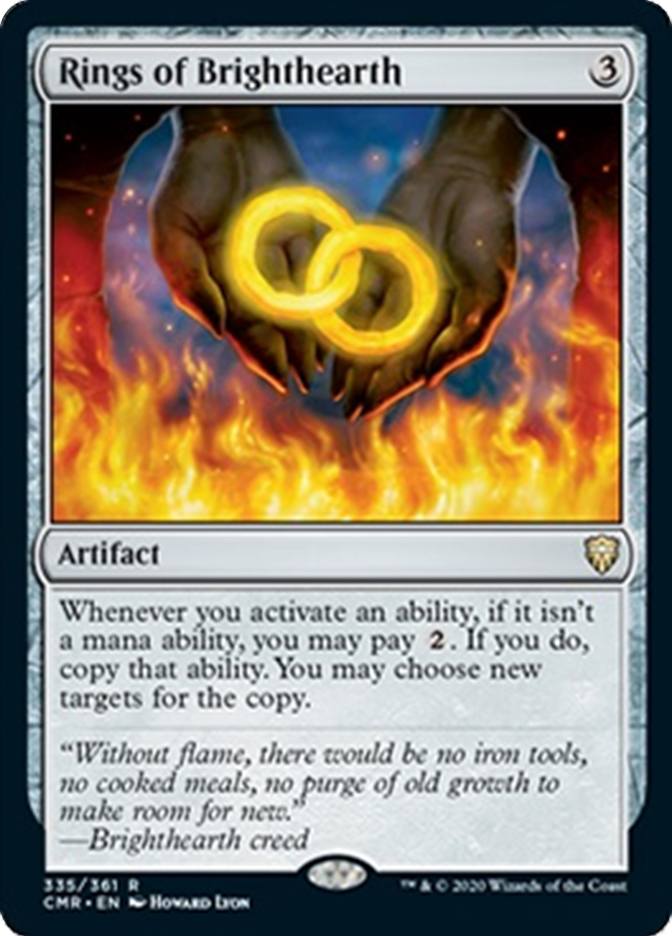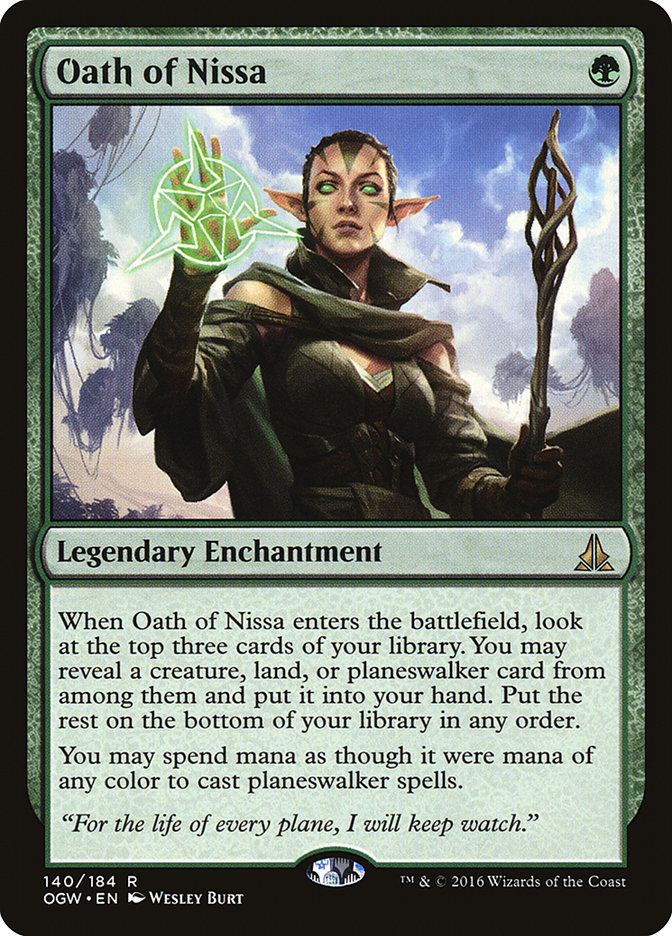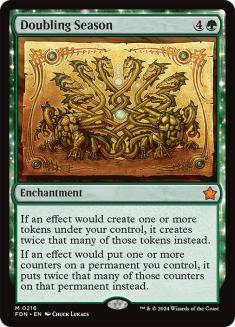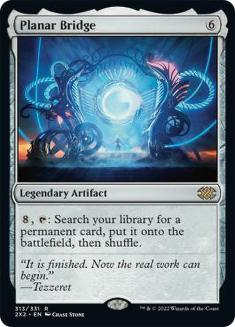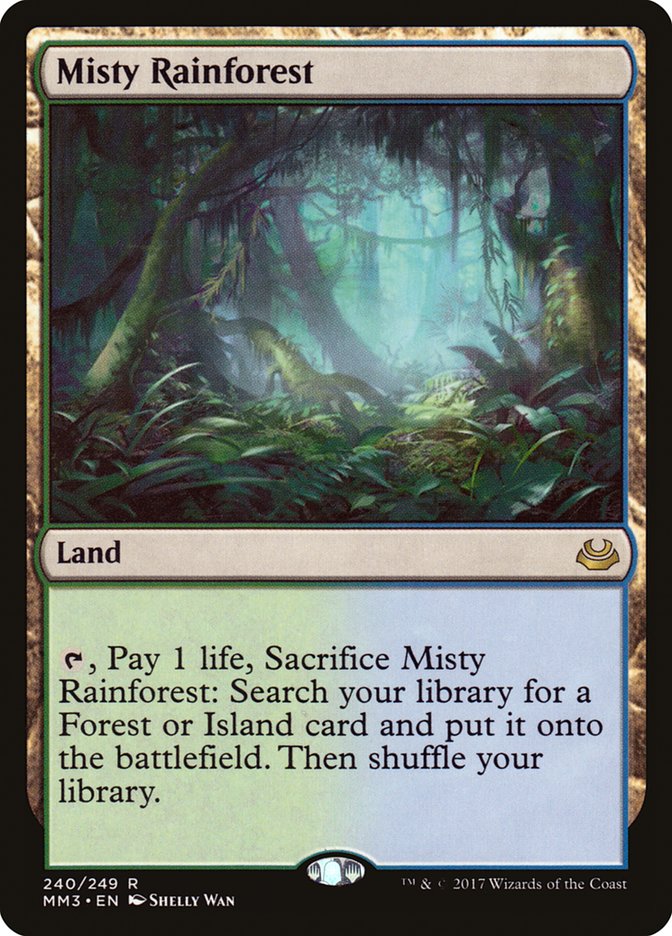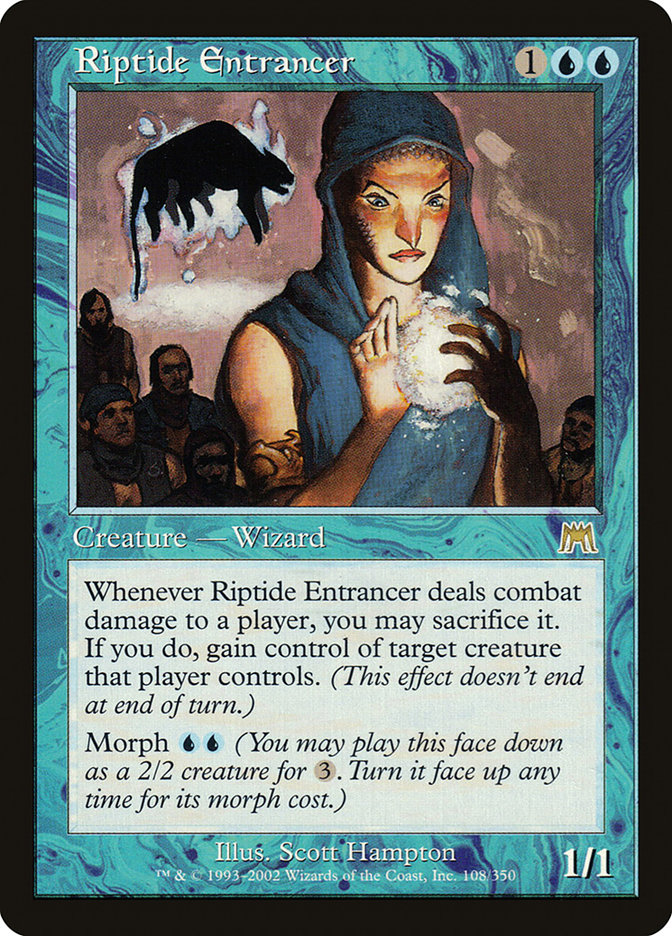We’re only a few weeks away from War of the Spark preview season, and the Magic community has become utterly obsessed with planeswalkers.
It makes sense. War of the Spark is going to have 36 brand new planeswalkers, giving Standard its largest pool of ‘walkers ever. Just to give you a sense of how monumental this is, most expansions have either two or three planeswalkers. Core Sets only have five. Heck, there are only 35 planeswalkers currently in the entire Standard format, and that includes the transformed side of Nicol Bolas and the fifteen underpowered Planeswalker Deck cards. There are only eighteen “proper” planeswalkers in Standard at the moment.
When War of the Spark releases, that number will triple.
It’s no surprise, then, that planeswalker-related cards have begun to spike. Mox Amber, for example, jumped from $8 up to $18 last week, since the card might find a top-tier home in a world with three times as many planeswalkers.
We talked about several planeswalker-related spikes last week, and we’ll get to a few more of them today. But first, I want to spend some time on the art of planeswalker analysis. After all, with 36 new ‘walkers to discuss, there will be many financially important decisions to make. Are there any signs that can signal a breakout versus a bust? Is it ever worth pre-ordering a $40 planeswalker? What can we learn from the relatively disappointing crop of planeswalkers in Ixalan and Guilds of Ravnica blocks? Let’s find out together.
What Do Valuable Planeswalkers Have in Common?
Since we’re hoping to find a secret formula for figuring out which new planeswalkers will have the most value, let’s begin by taking a look at the most expensive planeswalkers from Magic history and see if we can learn anything from them.
What planeswalkers should I put on this list? In order to be as objective as possible, I’ll make the calculation extremely straightforward. If it hit the $30 mark at any point after the pre-order period, it counts. Otherwise, I’m leaving it off. Here’s the list:
Keep in mind, this is not an exhaustive list of the best planeswalkers—just the most valuable in their day. Jace Beleren and Ajani Vengeant belong on every list of best planeswalkers, for example, but neither was ever that expensive due to a variety of other reasons. This is a finance article, though, and I wanted to do my best to stick with a list of the ‘walkers that you’d have been happiest pre-ordering due to their ability to build and maintain value.
Is there one color that dominates this list over any other? Well, here’s the breakdown:
|
Color Identity |
Number of Planeswalkers |
|
White |
5 |
|
Blue |
4 |
|
Black |
3 |
|
Red |
4 |
|
Green |
4 |
|
Multicolored |
6 |
|
Colorless |
3 |
This is a far more even split than I was expecting going in. In my mind, blue planeswalkers (especially Jaces) seemed like they would dominate this list. At the same time, I’m usually skeptical of multicolored planeswalkers because they tend to be more narrow in terms of competitive application. Nope.
The sample size here is too small to draw many conclusions, but I can pretty safely say that there is neither a good planeswalker color nor a bad planeswalker color. If a planeswalker is good, it’ll see play.
What about casting cost? Is that predictive at all?
|
Converted Mana Cost |
Number of Planeswalkers |
|
2 |
1 |
|
3 |
7 |
|
4 |
11 |
|
5 |
6 |
|
6 |
2 |
|
7 |
1 |
|
8 |
1 |
Well, now. Obviously Jace, Vryn’s Prodigy is a bit of an unusual case at converted mana cost two, and there aren’t many ‘walkers up at seven and eight, but it still appears that most of the value is clustered around the three- to five-mana camps.
Of course, we can’t really judge these numbers without knowing what the ratio of hits to misses looks likes. The fact that eleven planeswalkers at converted mana cost four “hit” looks impressive, but what if half the planeswalkers out there were printed at converted mana cost four? Then the number might not look all that impressive anymore.
For this next calculation, I think it’ll be most useful if I eliminate all planeswalkers that weren’t released in Standard-legal sets. That means no Commander releases and no Planeswalker Deck exclusives. I’ll have to leave Dack Fayden by the wayside for the time being, but I don’t want the approximately seven trillion horrible six-mana Planeswalker Deck exclusives to mess up my figures. I’m also going to ignore the five Magic Origins flip-walkers for now, since they’ve got their own bit of weirdness going on.
|
Converted Mana Cost |
Number of Hits |
|
3 |
4 out of 13 (30%) |
|
4 |
11 out of 41 (27%) |
|
5 |
6 out of 27 (22%) |
|
6 |
2 out of 9 (22%) |
|
7 |
1 out of 3 (33%) |
|
8 |
1 out of 2 (50%) |
These numbers are far more useful. The pattern here seems fairly simple, too: as the converted mana cost of a planeswalker increases, its chance of breaking out slowly drops. This trend breaks once you get up to converted mana cost seven, either due to small sample sizes or because expensive planeswalkers have a shot at being excellent control finishers in the right format. Other than that, cheaper cards are almost always better.
What about planeswalkers that protect themselves? The age-old planeswalker evaluation heuristic dictates that planeswalkers capable of protecting themselves are far better than planeswalkers that cannot. Does that hold true for this batch of valuable ‘walkers, or not?
|
Can Protect Themselves |
Number |
|
Well |
15 |
|
A Little |
10 |
|
Not at All |
4 |
This seems pretty conclusive to me. Good planeswalkers need ways to immediately interact with the battlefield, and it needs to be more than buffing your team or giving you a little bit of temporary offensive firepower. Spot removal, tapping, bouncing, making small token creatures…if a planeswalker can’t do one of these things, its chances of breaking out are far lower.
So far, then, we’ve mostly managed to codify a lot of stuff that seems reasonably obvious. We know that ‘walkers that can protect themselves are good, and we know that cheaper planeswalkers are safer bets than more expensive ones. We’ve also learned that multicolored planeswalkers can be just as good as monocolored planeswalkers, and that all five colors are roughly equal in terms of having breakout ‘walkers.
But what if I told you that there was a planeswalker in Standard right now that meets all of these criteria? A planeswalker with a converted mana cost of three, an excellent self-protection ability, and a totally solid color identity?
Well, there is. It’s Dovin, Grand Arbiter, a card that sells for just $5.
Yeah. We must dig a little deeper.
Examining Every Standard Planeswalker
When it comes to planeswalkers, there are two major factors that we’ve ignored so far.
First, planeswalker design has changed over time. Back in Lorwyn, planeswalkers like Jace Beleren and Garruk Wildspeaker were designed to be generically good. As long as you were playing blue, you had to at least consider running Jace. Ditto for Garruk in green.
These days, planeswalkers are far narrower. Sarkhan, Fireblood is really only going to see play in a deck with a critical mass of Dragons, and Domri, Chaos Bringer isn’t going to work in a deck that’s mostly spells. Kaya, Orzhov Usurper is a different sort of narrow: it can fit into any control deck, but it’s only useful against graveyard strategies and/or decks that tend to run nonland permanents with converted mana cost one or less.
This shift plays into our second major factor in planeswalker analysis—metagame dependency. Since planeswalkers are far narrower these days, they tend to rise and fall in popularity (and price) based on their current utility in the metagame. It’s far rarer to end up with a generically good planeswalker like Jace, the Mind Sculptor that is going to see play no matter what. It’s far more common to end up with something like Vivien Reid, a ‘walker who seemed like a bust until Golgari Midrange came along and gave it a top-tier home.
With that in mind, let’s look at every Standard planeswalker (again, excluding Planeswalker Deck exclusives) and see which ones ended up being worth the expensive pre-order.
Ravnica Allegiance
- Dovin, Grand Arbiter – $30 Preview, $5 Current
- Kaya, Orzhov Usurper – $25 Preview, $9 Current
- Domri, Chaos Bringer – $25 Preview, $6 Current
So far, not one planeswalker from Ravnica Allegiance has lived up to the hype. Kaya has come the closest as a role-player in the Esper Control sideboard, but you probably aren’t happy if you bought any of these cards early on. Luckily, this was pretty obvious at the time—I was pretty low on all three planeswalkers during my set review due to their high pre-order price and overall narrowness. Dovin felt like the closest to playable at the time, but the fact that we have an Azorius Aggro deck in the format that doesn’t run him is pretty damning. None of his abilities does enough, unfortunately.
Guilds of Ravnica
- Vraska, Golgari Queen – $20 Preview, $5 Current
- Ral, Izzet Viceroy – $15 Preview, $7 Current
Both of these planeswalkers had brief moments of relevance in Standard, but neither of them amounted to much financially. Even when Vraska was seeing play in Golgari Midrange, she didn’t spike above her preview price. It seems a little odd that none of the planeswalkers in this latest Ravnica block has done anything, but it’s true.
Core Set 2019
- Tezzeret, Artifice Master – $25 Preview, $8 Current
- Ajani, Adversary of Tyrants – $20 Preview, $16 Current
- Vivien Reid – $20 Preview, $30 Current
- Liliana, Untouched by Death – $15 Preview, $5 Current
- Sarkhan, Fireblood – $15 Preview, $9 Current
We have our first winner! Vivien Reid looked like a bust at first, dropping from $20 down to $10 for the first few months of its life in Standard, but the rise of Golgari Midrange made Viven one of the most powerful cards in Standard overnight. It jumped to $25 a few days after Guilds of Ravnica hit shelves, and it hasn’t dropped much since.
Otherwise, these Core Set 2019 planeswalkers have remained fairly disappointing. Ajani has had his moments, and Sarkhan showed up in an interesting rogue deck over the summer, but none of the other four was worth buying during the preview period.
Tezzeret, Artifice Master is by far the most disappointing card on this list. Back during Core Set 2019 previews, a few top-level pros were calling Tezzeret the best card in the set. It’s still easy to see why. Tezzeret has a +1 ability that protects him very well, a second ability that can draw you multiple cards a turn, and an ultimate that straight-up wins the game. What the heck happened?
It’s actually pretty simple. Tezzeret has a casting cost of five. So does Teferi, Hero of Dominaria. While I’m not convinced that Esper Control would run Tezzeret, Artifice Master if Teferi weren’t available, there’s no chance that the deck is going to run Tezzeret as long as Teferi remains an option. And since I can’t really see a deck developing that wants to run Tezzeret over Teferi, this otherwise-powerful card has almost no shot at breaking out during the rest of its run in Standard.
This is worth keeping in mind during War of the Spark previews. If the set gives us a reasonably expensive control ‘walker that looks incredibly good in a vacuum, remember that it still has to compete against Teferi until October.
Dominaria
- Karn, Scion of Urza – $40 Preview, $23 Current, $75 Highest
- Teferi, Hero of Dominaria – $15 Preview, $55 Current
- Jaya Ballard – $10 Preview, $2 Current
We got there! Dominaria actually had two planeswalkers that would have been good to pre-order. Not only was Teferi the breakout card of the summer, but Karn spent a couple of weeks above the $70 mark. As long as you sold at or near Karn’s peak, you would have been pretty happy with your $40 pre-order on him as well.
We’ve talked about Teferi a bunch already, but let’s take a moment to revel in the upside here. There is nothing quite as exciting as making a bet on a brand-new planeswalker and ending up with the breakout card of the set. The initial buy-in was just $15, and Teferi has been selling at or around the $60 mark for months now. If you bought your playset in April 2018 instead of October 2018, you would have saved $180. If you bought a few extra playsets, you might have been able to play Magic for free all winter. This is why I’m writing this article, and it’s why we have to pay close attention to all the new planeswalkers in War of the Spark. When a planeswalker hits, it can be the most valuable card in Standard for years.
Rivals of Ixalan
- Angrath, the Flame-Chained – $15 Preview, $13 Current, $20 Highest
- Huatli, Radiant Champion – $15 Preview, $6 Current
Neither planeswalker in Rivals had much hype behind them, but Angrath ended up holding its value better than most. Granted, this had more to do with anemic sales for the set and a lack of overall supply, since Angrath hasn’t actually seen much play and its spike to $20 had more to do with its potential to combo with Rakdos cards ahead of Ravnica Allegiance than anything resembling a Tier 1 Standard deck. Even so, this is more of an example of a card that wouldn’t have been horrible to pre-order rather than a resounding victory.
Ixalan
- Jace, Cunning Castaway – $25 Preview, $3 Current
- Vraska, Relic Seeker – $20 Preview, $5 Current, $30 Highest
- Huatli, Warrior Poet – $20 Preview, $3 Current
Mechanically, Jace, Cunning Castaway isn’t that far off from Dovin, Grand Arbiter. The fact that Mono-Blue Tempo is one of the best decks in Standard and it still doesn’t run either of these cards says it all, doesn’t it? Since Wizards of the Coast seems to like recycling this design, let’s try not to buy in a third time.
On the other hand, Vraska, Relic Seeker is one of the few six-mana planeswalkers that would have been fine to pre-order. It had two different spikes toward the $30 mark, and I suspect it would have seen a lot more play had Vivien Reid not come along to give Golgari decks a slightly more affordable shot at repeatable artifact and enchantment removal. This is definitely an ability that green-based decks want, though, and it’s something I’ll be looking out for in the future.
The Power of Diversity
After spending a couple of days thinking about planeswalkers, one factor keeps rising above all the rest in my thinking about what makes a planeswalker valuable. It’s not raw power; it’s a strong and diverse suite of abilities.
Consider Gideon, Ally of Zendikar, a card that defined Standard for at least six months. No matter what state your game was in, Gideon gave you a line of attack. Way ahead on the battlefield? Emblem immediately and swing in with your army. At parity or in a tight race? Use the +1 and swing in. Behind or in a slower race? Start making 2/2 Knights.
Vivien Reid is kind of like this as well. Her -3 ability kills artifacts, enchantments, and flying creatures, which means that she’s incredibly powerful in three entirely different situations, regardless of whether you’re ahead, behind, or at parity. Oh—and her +1 is good no matter what, not just drawing you an extra card but a card that’s almost guaranteed to be good.
Compare that to Dovin, Grand Arbiter. You can get a bunch of loyalty on him fast if you’re ahead on the battlefield, but you still have to take him from three up to seven in order to get anything to happen. If you’re behind, making a 1/1 Thopter isn’t the worst, but it only happens while you’re ticking Dovin down, which makes for a really poor initial turn. Essentially, Dovin has one line of intended play—get a bunch of creatures on the battlefield, cast Dovin, swing in with him, tick him up a bunch, and then either make Thopters or draw cards. If you’re not doing that, Dovin is awkward.
This is the same thing that makes Hydroid Krasis so good. Sometimes you’ll have a lot of mana, and sometimes you won’t. Sometimes you’ll need a big body on the battlefield, and sometimes you’ll need cards. Hydroid Krasis is sometimes good and sometimes great, but it’s rarely just a dead draw. If you’re looking for planeswalkers that will be valuable and impactful, keep this in mind.
What I’ll Be Looking For in War of the Spark
The most valuable card in War of the Spark would be some sort of upgrade to Teferi, Hero of Dominaria. This would make for a risky spec, though—if the card looks slightly better but ends up being slightly worse, than you’ll end up with another Tezzeret, Artifice Master situation. That spec might pay off after Teferi rotates, but you’ll still have two other sets of potential control planeswalkers to fight through at that point, not to mention other major shifts in the metagame.
Next, I’ll be taking a long and hard look at all of the three-mana planeswalkers. While I doubt we’re getting another Modern staple on the level of Liliana of the Veil or Liliana, the Last Hope, I’m looking for cards that remind me of those two. At three mana, raw diversity is more important than any specific list of abilities—we want something that provides its pilot with a couple of different options on Turn 3, not a card that’s only good in exactly one context.
After that, I’ll be on the lookout for four-mana flagship planeswalkers, cards like Gideon, Ally of Zendikar or Chandra, Torch of Defiance. Again, these cards provide both power and diverse utility, which are the marks of a great planeswalker. Again, the more lines of play open up thanks to a planeswalker, the better it tends to be.
Lastly, I’ll be taking a look at any seven-plus-mana planeswalkers, especially if they’re colorless. If a card can end the game right away, especially in Modern Tron, it’s worth considering.
In terms of buy-in cost, nothing is disqualifying if you’re secure enough in your evaluation. Karn, Scion of Urza was a solid buy at $40 during the pre-order period, while Teferi, Hero of Dominaria was a steal at $15. I don’t think I’ve ever felt confident enough about an evaluation of mine to pre-order a card at $40, but recent history has proven that it can be correct if the situation is right. Elite planeswalkers can spend months at $60, and my guess is that War of the Spark will have at least one elite planeswalker. Here’s hoping we can find it together.
Analyzing the Planeswalker-Adjacent Spikes
Even though I’ve spent the entire article hyping up War of the Spark‘s planeswalkers, I actually expect that very few of them will be playable in Standard. “Every pack has a planeswalker” is a super-exciting concept, but in order to make the set work without warping the entire format, some of them are probably going to be at common, uncommon, and rare. We haven’t seen a planeswalker below mythic since the mythic rarity was invented, and I wouldn’t be shocked if most of these lower-tier ‘walkers aren’t playable outside of Limited.
This will be fine. We don’t really want a Standard environment with a trillion mythic planeswalkers anyway, and WotC knows that the set will have to have a small number of “pushed” planeswalkers regardless. Even if only three or four of them end up being good, that’s still a far higher hit rate than every other set of planeswalkers ever.
That said, I expect a decent amount of disappointment once previews begin and we see the first common or uncommon planeswalkers. Too many people out there really do think that we’re getting 36 mythic ‘walkers, and they’re the sort of people driving the market for planeswalker-adjacent specs. Because of that, I feel like you should be selling most of these cards now, before previews actually begin. Don’t wait around for the hype to die, or you might end up holding too long.
Which cards are spiking right now? Quite a few, actually. In Standard, Mox Amber, The Immortal Sun, Oath of Teferi, and Bedevil were all up this week. The Immortal Sun was the biggest gainer of the week by far, jumping about $10, but I remain pretty unconvinced that this card is going to do much in Standard outside sideboard situations. It’s still a decent long-term casual hold, but I’m selling into the hype.
Bedevil seems better to me. For one, it hasn’t really spiked yet, and it’s the sort of card that will immediately become a staple if Rakdos colors end up being more playable at some point while it’s in Standard. At the very least, Vraska’s Contempt will rotate out of the format this fall and Bedevil should see an uptick in play then.
Outside of Standard, we’ve got a bigger list of planeswalker-related spikes:
Some people seem pretty sure that The Chain Veil will be reprinted, but Oath of Teferi does something similar in Standard and there are story reasons why the card is probably not going to be in War of the Spark. Also, I suspect that the vast majority of the mythic rare slots in the set—if not all the mythic rare slots—will be devoted to planeswalkers.
I’m a little higher on the non-Standard cards going forward, primarily because of Commander. Even if very few of the War of the Spark ‘walkers end up being playable in Standard, the set is going to lead a massive number of Commander players to build “Superfriends”-style decks that are chock-full of planeswalkers. So while I’m fading cards like Mox Amber and The Immortal Sun, I actually wouldn’t be surprised to see cards like The Chain Veil and Doubling Season continue to tick up over the next month or two. Selling now is still the safe play, but I don’t think it’s as clear-cut as many of the other decisions we’ve talked about this week.
This Week’s Trends
Things have been relatively quiet in Standard as of late. Last fall’s Standard metagame was defined by constant flux, but the current metagame’s top tier has been fairly stable recently. Mono-Blue Aggro, Simic Nexus, Sultai Midrange, Azorius Aggro, Esper Control, and Izzet Phoenix were all known decks at the Mythic Championship, and they’re all still seeing some amount of play. As such, the Standard market has been quite stable recently.
One new deck that has begun to break out recently, however, is Gruul Aggro. This brew is currently the fifth-most-popular Standard deck on Magic Online, and it has put up quite a few respectable finishes lately as well.
Financially, the market hasn’t really reacted to Gruul Aggro yet. Growth-Chamber Guardian is still $3.50, Gruul Spellbreaker is still $2.50, and the deck’s flagship mythic, Rekindling Phoenix, is still possible find for $20 or less if you look hard enough. (It’s sold out at $25 on Star City Games, which better reflects the immediate future price of the card.) All three of these cards should be on the rise soon, with Goblin Chainwhirler, Dire-Fleet Daredevil, and Stomping Ground on my radar as well. It’s worth trading for all six of these cards at current retail, and Rekindling Phoenix has $40+ upside depending on how the metagame evolves after War of the Spark.
We’ve already talked about the three cards that gained the most value in Standard this week—The Immortal Sun, Oath of Teferi, and Bedevil—so let’s move on to Modern. Other than the planeswalker-related spikes, it was another good week for fetchlands. Misty Rainforest keeps surging in price, and both Verdant Catacombs and Polluted Delta are on their way up as well. Everyone wants to snag their Modern manabases ahead of Modern Horizons, and I can’t blame them. Expect these sorts of slow and steady gains to keep happening throughout the rest of the spring.
There were a few non-planeswalker Commander spikes this week as well. Paradox Engine is on the rise again, to the surprise of absolutely nobody who plays a lot of Commander. This is one of the most absurd engines in the format, and you can play it in practically any deck. It’s only going to keep rising until it gets reprinted.
On the flip side, there’s Riptide Entrancer. This Onslaught rare does see a little bit of play in Commander, but probably not enough to justify a spike from $2 to $8. At the very least, somebody decided to force the issue via buyout. Riptide Entrancer is a very-low-supply card, but stability in the $3-$4 range seems more likely to me than continued gains.
Lastly, WotC announced last week that they’re completely refurbishing the Wizards Play Network, which is going to change how FNM and other promotional foils are distributed in a pretty major way. While we don’t have enough information yet to know how this might affect the market, my guess is that we’ll be getting more promotional foils overall. I’ll keep you updated on the financial implications of these changes as we learn more.


